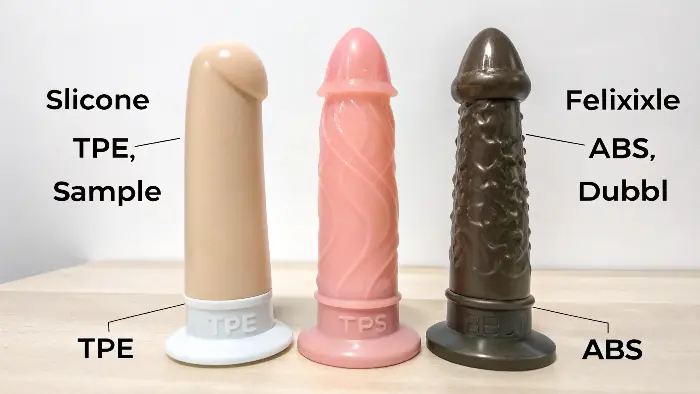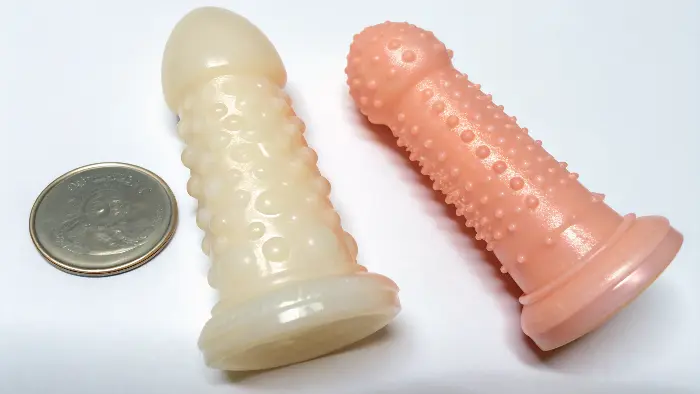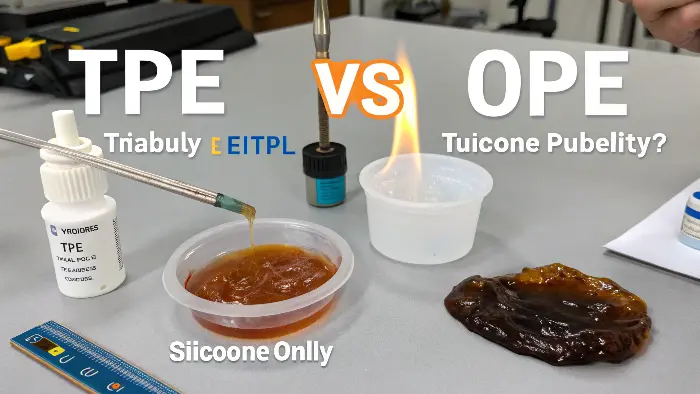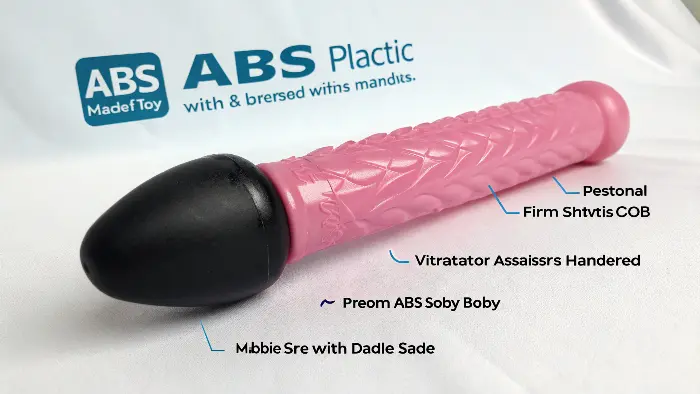Struggling to pick the right material for your adult toys? The wrong choice can wreck user experience and your brand’s image. Let’s dive into silicone, TPE, and ABS to make it clear.
Silicone often stands out as the premium choice for safety and durability, especially medical-grade. TPE offers a very realistic, skin-like feel at a more budget-friendly price point but is porous. ABS is a hard, body-safe plastic, perfect for firm toys or internal components like vibrator casings. Each material has its specific strengths and ideal uses.

Okay, so you’ve got the quick rundown. But as a fellow brand owner or sourcing manager, you know the real story is in the nitty-gritty details. Choosing the right material isn’t just a small decision; it’s fundamental to your product’s success, your customers’ safety, and your brand’s reputation. I’ve seen so many businesses stumble right here, and honestly, it’s an easy mistake to avoid if you’re well-informed. So, let’s really get into the weeds with these materials. I want to share what I’ve learned over the years so you can make the best call for your products.
Which is safer: silicone or TPE?
Worried sick about product safety and how it impacts your customers? Using materials that aren’t up to snuff can lead to health scares, bad press, and totally erode the trust you’ve built. So, let’s put silicone and TPE head-to-head on safety.
Generally, medical-grade silicone is considered the safer option compared to TPE for adult toys. Silicone is non-porous, meaning it doesn’t harbor bacteria, it’s hypoallergenic, and inherently body-safe. TPE, on the other hand, can be porous, making it harder to clean thoroughly, and some formulations might cause reactions in more sensitive individuals.

When we talk safety in adult toys, it’s a non-negotiable, right? Your customers are placing a huge amount of trust in you. I always tell people, if you’re going to invest anywhere, invest in safe materials.
Why Silicone Often Wins on Safety
Silicone, especially the medical-grade stuff, is kind of the gold standard. Its biggest win is being non-porous. Think about it – no tiny holes for bacteria or fungi to hide in. This makes it super easy to clean and keep hygienic. Plus, it’s generally hypoallergenic, so the chances of it causing an allergic reaction are really, really low. It’s also very stable; it doesn’t break down or leach weird chemicals, which is a huge peace of mind. We’ve made the switch to medical-grade silicone for most of our PrivyPlay line for exactly these reasons. The customer feedback on comfort and confidence has been amazing.
TPE Safety Considerations
Now, TPE (Thermoplastic Elastomer) can be a bit more of a mixed bag. The main thing to watch out for is its porosity. Because it can have microscopic pores, it needs more diligent cleaning to prevent bacteria buildup. If a TPE toy isn’t cleaned properly, well, it can become a bit of a germ party. Also, "TPE" is a broad category. Quality varies wildly. You can get body-safe TPEs, and many are perfectly fine, but you have to be sure of your supplier and their material certifications. Cheaper TPEs might sometimes contain plasticizers or other additives that could be irritants for some people. I remember one instance early in my career, not with PrivyPlay, where a batch of TPE products caused minor skin irritation for a small percentage of users. It turned out to be a less-than-ideal TPE formulation. Lesson learned: always verify your TPE source and its body-safe credentials!
Here’s a quick table to sum it up:
| Feature | Silicone (Medical-Grade) | TPE (Body-Safe Grade) |
|---|---|---|
| Porosity | Non-Porous | Can be Porous |
| Hypoallergenic | High | Moderate |
| Cleaning Ease | Very Easy | More Difficult |
| Bacteria Risk | Very Low | Higher if not cleaned |
| Chemical Safety | Excellent | Good (if certified) |
Ultimately, while good quality TPE can be safe, silicone generally offers a higher level of inherent safety and ease of mind.
Does silicone last longer than TPE?
Are you fed up with products that seem to give up the ghost way too soon? Customers expect their purchases to last, and dealing with returns or scathing reviews because a toy didn’t hold up is a headache. Let’s investigate which material, silicone or TPE, truly goes the distance.
Yes, silicone almost always outlasts TPE, often by a significant margin. Silicone is exceptionally durable, standing up well to wear and tear, heat, and water. TPE, being generally softer and more flexible, is more susceptible to tearing, showing signs of wear more quickly, and can be damaged by improper cleaning or storage conditions.
![]()
Durability is a big deal. Nobody wants to invest in a product, especially an intimate one, only for it to fall apart after a few uses. As a brand, offering durable products builds trust and reduces so many post-sale headaches.
Silicone’s Endurance Secrets
Silicone is a real workhorse. It’s incredibly resistant to tearing and abrasion. You can twist it, stretch it (within reason!), and it just bounces back. A huge plus is its heat resistance. Many silicone toys can be boiled for sterilization, which is fantastic for hygiene and doesn’t degrade the material. It’s also completely waterproof. Over time, silicone maintains its shape, texture, and integrity really well. I’ve got silicone product samples in my office that are years old and still look and feel practically new. That’s the kind of longevity that makes customers happy.
TPE’s Lifespan Limitations
TPE, while offering that lovely soft, skin-like feel, generally doesn’t have the same staying power as silicone. Because it’s often softer, it’s more susceptible to nicks, cuts, and tears, especially if it’s a very pliable formulation. Certain chemicals, like oil-based lubricants or harsh cleaners, can actually cause TPE to degrade, sometimes making it feel sticky or even start to break down. It also has a lower heat tolerance than silicone. I’ve seen TPE toys get a bit misshapen or develop a weird texture if they were, say, accidentally left in a really hot car or near a radiator. Silicone just wouldn’t bat an eyelid at that. While a good quality TPE toy can last a decent amount of time with proper care, it generally won’t match the sheer resilience of silicone.
Let’s lay it out:
| Property | Silicone | TPE |
|---|---|---|
| Tear Resistance | High | Moderate to Low |
| Heat Resistance | High (often boil-safe) | Low to Moderate |
| Chemical Resist. | Excellent (except silicone lube!) | Variable, can degrade |
| Longevity | Excellent | Fair to Good |
| Feel Over Time | Stays consistent | Can become sticky/deform |
So, if maximum durability and a long product life are top priorities, silicone is usually the way to go. TPE can still be a great option, especially for its feel and cost, but it requires a bit more TLC from the user to maximize its lifespan.
How can you tell the difference between TPE and silicone?
Ever get that sample in and think, "Hmm, is this really the premium silicone I ordered, or a very convincing TPE?" It happens! Misidentifying materials can lead to incorrect product claims, using the wrong lubricants, and ultimately, unhappy customers. So, let’s look at some ways to spot the difference.
You can often distinguish TPE from silicone by touch, smell, and a careful flame test. Silicone usually feels smoother, less sticky, and is odorless. TPE can feel slightly tacky or oily and might have a faint chemical or rubbery smell. For a more definitive test (use extreme caution!), silicone burns to a white ash with little smoke, while TPE melts, drips, and produces black, sooty smoke.

Knowing your materials is crucial, especially when you’re sourcing from new suppliers or trying to verify quality. I’ve had a few instances where a sample wasn’t quite what it was claimed to be, and these little tests saved us a lot of trouble down the line.
Simple At-Home Tests (Use Common Sense!)
You don’t always need a lab to get a good idea of what you’re dealing with. Here are a few practical tests:
- The Feel Test: Run your fingers over the material. High-quality silicone usually has a very smooth, almost silky feel. It’s not typically sticky. TPE can also be very soft, but sometimes it has a slightly grippy, tacky, or even a faintly oily sensation, especially in softer formulations.
- The Stretch Test: Gently stretch the material. Silicone generally has excellent elasticity and will return to its original shape quite well. While TPE is also stretchy, some formulations might stretch out more permanently or could tear more easily if overstretched, especially lower-quality TPE.
- The Smell Test: Give it a sniff. Silicone is virtually odorless. If you detect any chemical, plastic-y, or rubbery smell, it’s more likely to be TPE (or another material entirely).
- The Flame Test (EXTREME CAUTION!): This is the most definitive but also requires care. Please, if you do this, use a tiny, insignificant piece of the material, hold it with tweezers over a non-flammable surface (like a ceramic plate), and away from anything flammable.
- Silicone: When exposed to a flame, silicone doesn’t really melt and drip like plastic. It will eventually burn, but it tends to turn into a white, brittle ash. There’s usually very little smoke, and it doesn’t smell like burning plastic.
- TPE: TPE behaves more like plastic. It will melt, often drip, and produce black, sooty smoke. It will also typically have a distinct smell of burning plastic or rubber.
I can’t stress the caution enough with the flame test. But, I have to admit, it’s caught out a supplier or two in my time who tried to pass off a high-grade TPE as silicone. The price difference can be significant, so some less scrupulous folks might try it.
Why It Matters for Sourcing
Knowing these differences is vital. First, you want to ensure you’re getting what you paid for – silicone is generally more expensive than TPE. Second, you need to provide accurate product descriptions and care instructions to your customers. For example, telling someone a TPE toy is silicone could lead them to use a silicone-based lubricant, which can degrade TPE over time. It’s all about transparency and quality control.
Here’s a quick reference:
| Test | Silicone Result | TPE Result |
|---|---|---|
| Touch | Smooth, silky, not sticky | Can be soft, sometimes slightly tacky/oily |
| Smell | Odorless | Faint plastic/chemical/rubbery smell possible |
| Stretch | Good elasticity, returns to shape | Can overstretch, tear more easily |
| Flame (Careful!) | Burns to white ash, little smoke | Melts, drips, black sooty smoke, plastic smell |
These simple checks can be surprisingly effective in your day-to-day sourcing and quality control.
And What’s the Deal with ABS Plastic in Adult Toys?
You’ve probably heard about ABS plastic, but maybe you’re wondering where it fits into the adult toy landscape, especially next to softer materials like silicone and TPE. You definitely don’t want to overlook a material that could be the perfect solution for certain designs or components. So, let’s explore the role of ABS.
ABS (Acrylonitrile Butadiene Styrene) is a common, rigid, impact-resistant, and body-safe thermoplastic. In adult toys, it’s excellent for creating firm structures like vibrator casings, handles, bullet vibes, or non-flexible dildos. It’s non-porous, easy to clean, and transmits vibrations well, but it offers no softness or flexibility itself.

ABS is kind of an unsung hero in the adult toy world. It might not have the sensual, skin-like appeal of silicone or TPE, but it plays a crucial role in many, many products. Think of it as the strong skeleton or the reliable housing for the fun stuff!
The Strengths of ABS
ABS plastic brings several key advantages to the table, especially when firmness and structure are needed:
- Rigidity and Strength: This is its main superpower. ABS is hard and holds its shape, making it perfect for parts that need to be sturdy – like the main body of a wand vibrator or the handle of an insertable toy.
- Non-Porous & Hygienic: Just like silicone, ABS is non-porous. This means it doesn’t harbor bacteria and is super easy to clean with soap and water or a toy cleaner.
- Impact Resistance: ABS is tough. It can withstand drops and knocks without easily cracking or breaking, which adds to a product’s overall durability.
- Good Vibration Conductor: Because it’s rigid, ABS transmits vibrations very effectively. This is why it’s so commonly used for the casings of vibrators – it helps ensure those good vibes get where they need to go!
- Cost-Effective: For rigid components, ABS is generally a more budget-friendly option than trying to achieve the same firmness with other materials.
When to Choose ABS (and When Not To)
So, where does ABS really shine?
- Ideal for: Vibrator casings (especially for powerful motors that need a solid housing), bullet vibes, the bodies of wand massagers, handles for dildos or other toys, and any internal structural components. I’ve seen it used for some uniquely shaped, entirely rigid dildos too.
- Not suitable for: Any product or part of a product that needs to be soft, flexible, or have a skin-like feel. You wouldn’t make a super soft, squishy dildo entirely out of ABS, for example. Well, unless it was a very specific, artistic, and probably not very comfortable niche! 😉
We use ABS quite a bit at PrivyPlay for things like the control buttons on our vibrators or the internal chassis that holds the motor securely. It allows us to create sleek, durable designs that feel solid and reliable in the hand.
Here’s a quick look at ABS:
| Feature | ABS Plastic |
|---|---|
| Texture | Hard, smooth |
| Flexibility | None (Rigid) |
| Porosity | Non-Porous |
| Durability | High (impact resistant) |
| Use Cases | Casings, handles, firm toys, internal parts |
| Cleaning | Easy |
| Lube Comp. | Water-based, Silicone-based (usually fine for external parts) |
ABS is a fantastic, practical material. It might not be the star of the show in terms of direct sensual feeling, but it’s an essential supporting actor that makes many of our favorite toys possible and pleasurable.
Conclusion
Choosing between silicone, TPE, and ABS really boils down to your specific product’s design, the feel you’re aiming for, and your budget. Always put safety first and be crystal clear with your customers. You’re now way better equipped to pick the perfect material! 🔥
